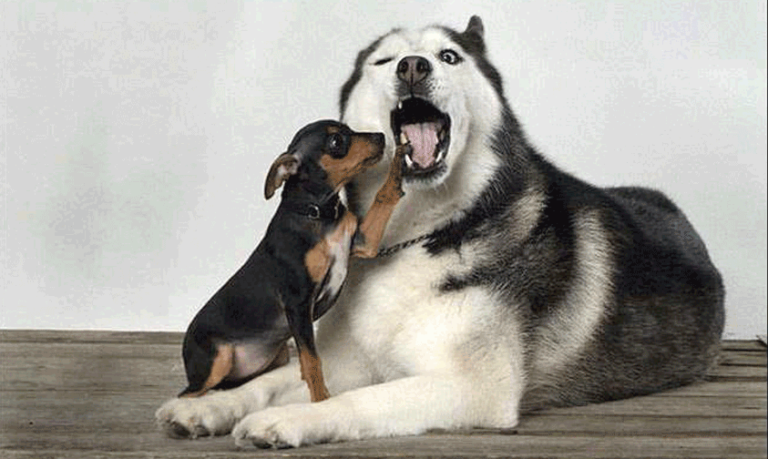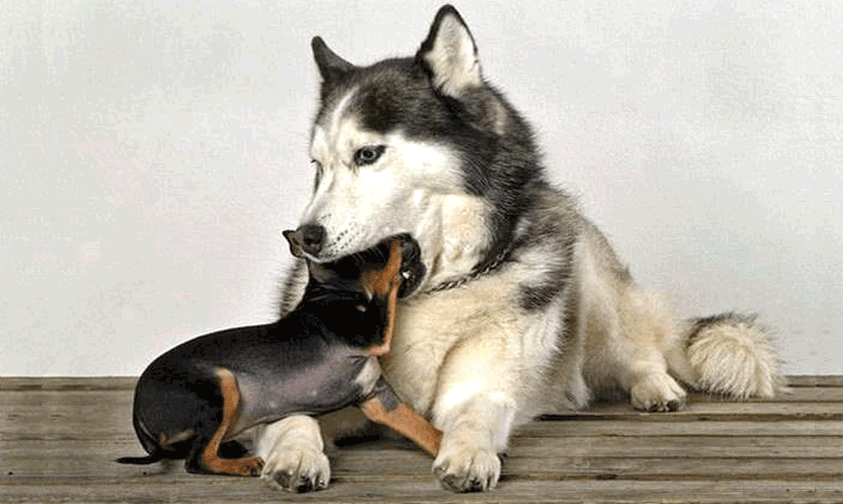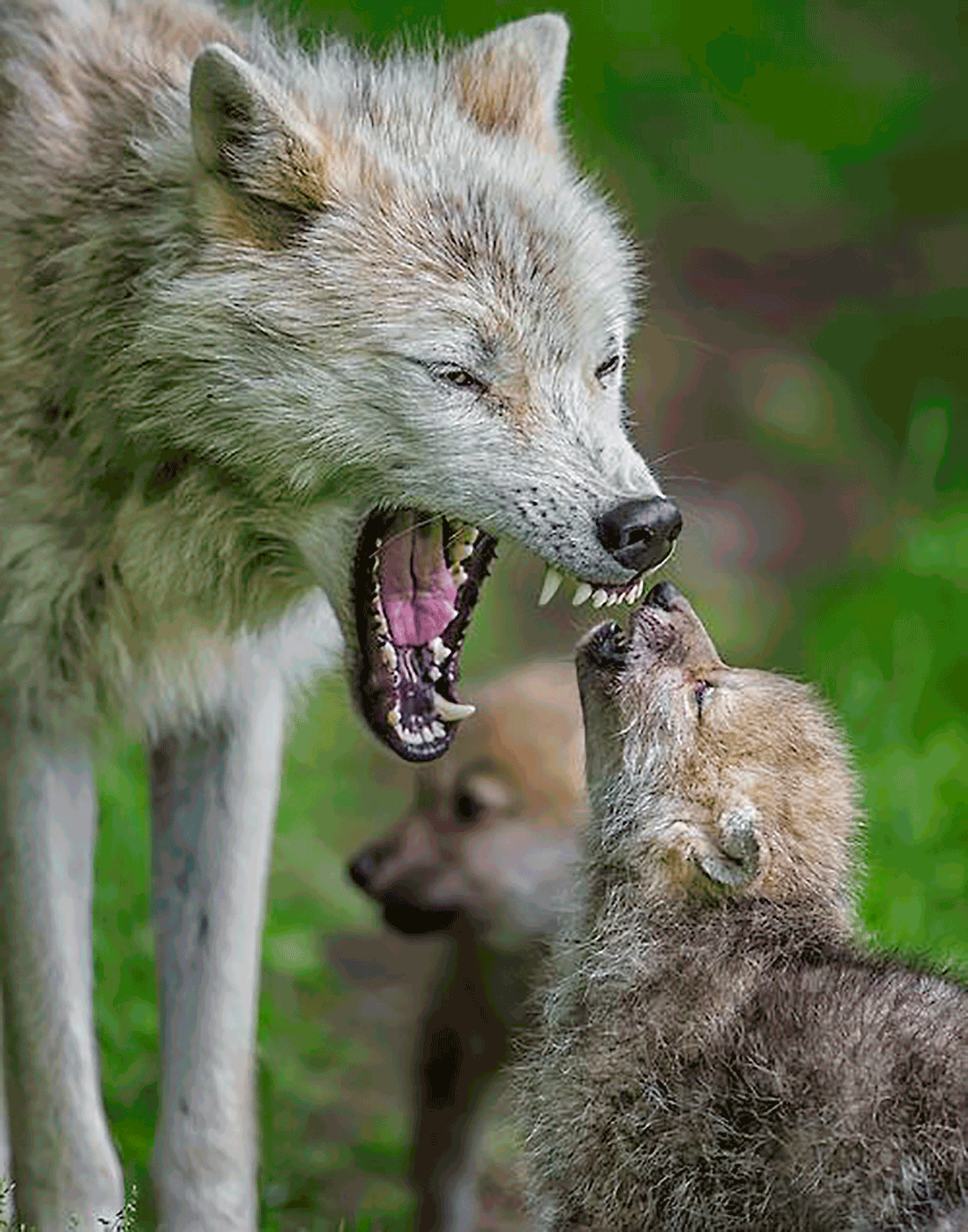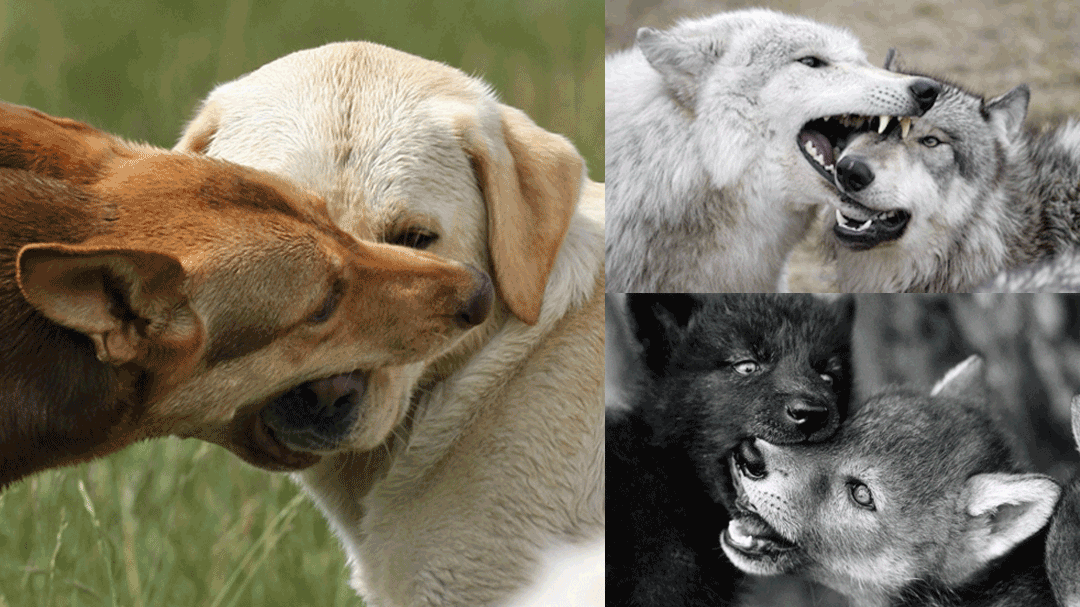The canine muzzle nudge is a pacifying behavior. Pacifying behavior (Latin pacificare, from pax = peace and facere, facio= to make) is all behavior with the function of decreasing or suppressing an opponent’s aggressive or dominant behavior.
Newborn cubs and pups nudge their mother’s tits to find a nipple and suckle the maternal milk, their only nutrition by then. The nudging, achieving the desired result, becomes imprinted in their memories. Later, they will frequently nudge to attempt to obtain something they want or to turn an unpleasant situation into a pleasant one.
The muzzle nudge is a typical canine behavior: one individual nudges the sides of the mouth of another. It may elicit regurgitation when accompanied by licking. That is how infantile canines taste their first fast food.
Regurgitation behavior is shown by adult canines when they vomit recently consumed food right in front of youngsters. It may occur voluntarily, though often it is the muzzle nudge of the youngsters that triggers it. Their mother is the first to regurgitate for them, but other members of the pack may also join in.
The husky shows yawning, a common canine pacifying behavior. The little dog shows pawing, also a common pacifying behavior, and the beginning of poking to the sides of the mouth, which has the function of eliciting regurgitation (photo by unknown; if you’re the photographer, please let us know as we would like to give you due credit).


The muzzle nudge later assumes a ritualized function as a pacifying behavior. Insecure or slightly fearful individuals will muzzle nudge their opponents, showing them their friendly intentions. Our dogs will muzzle nudge us in many situations when they feel unsafe, somewhat pressured, or just in need of being reassured. They may direct their muzzle nudge toward any part of our body, most often though toward our face and hands. They may also attempt to lick us.
The muzzle grasp behavior may have its origins in the muzzle nudge and regurgitation. Adults muzzle-grasp youngsters, which often invite them to perform this ritual. Canine mothers use a version of this behavior to prevent their youngsters from suckling at the time of weaning. Higher-ranking canines in a pack (wild and domestic) use another version of this behavior to make a point as to claiming a resource. In all cases, this behavior causes no harm and injury. The muzzle grasp is not an aggressive behavior. It ranges from pacifying to self-confident and dominant behavior depending on the variation, intensity and the individuals concerned.
Muzzle nudge, muzzle grasp, and regurgitation are connected. They share the common element of originating in the satisfying of a primary need (food acquisition). They all involve some nudging, and they focus on the mouth of the adults.
The pictures on these pages how the Husky yawning (pacifying behavior) and the little dog pawing it (yet a pacifying behavior) while attentive to its mouth. On the second picture, the pup, not only nudges and licks the sides of the mouth of the adult, but it also sticks its head in. This is rare and due to the difference is the size of the dogs. It is not uncommon, though, for the nudging and licking to become so intense that the youngster sticks its nose in the adult’s mouth.
An adult wolf regurgitates to a very attentive and eager cub. That is a behavior all adults will show toward cubs. This author has witnessed barely nine months females regurgitate to a cub in a pack where they were the oldest. Domestic dogs also regurgitate to pups, although not as regularly as their wild cousins (photo by unknown).

Although not as common as in nature, some of our domestic dogs also show the regurgitation behavior when given the opportunity. They will regurgitate not only toward their puppies but also toward unrelated puppies. This behavior has nothing to do with nervousness, agitation, or illness as erroneously assumed by many dog owners. It is a vestige of behavior our dogs inherited from their ancestors when feeding the pups was a highly crucial trait and favored by natural selection.
The muzzle nudge behavior shows friendliness. A dog displaying an unsolicited muzzle nudge too often may be a dog feeling insecure and in need of comfort.
The muzzle grasp is social behavior. It is one of those behaviors favored by natural selection for its essential functions and effectiveness. It is common in pacifying rituals, often at the invitation of the more vulnerable individual. It is also in the repertoire of an individual to claim a resource (showing its dominant behavior in that situation). Our dogs may welcome us to muzzle-grasp them as a bonding activity. The canine muzzle grasp and our gentle grasping the muzzle of our dog has nothing to do with the brutal grabbing of the dog by the muzzle as some dog owners do when venting their frustration.
Muzzle nudge, muzzle grasp, and regurgitation behavior may assume many variations depending on the individuals involved, context, environment, etc. Behavior if a continuum and except for tropisms and simple reflexes, it is highly individualized. Natural selection favors behaviors that tend to be advantageous in the struggle for survival and reproduction.
References
Abrantes, R. (1997) The Evolution of Canine Social Behavior. Naperville: Wakan Tanka Publishers. (also available in Italian and Czech). ISBN-13: 9780966048414. ISBN-10: 0966048415.
Abrantes, R. (1997) Dog Language. Wakan Tanka Publishers. (Also available in Danish, Swedish, German, Italian, Spanish and Czech). ISBN-13: 9780966048407 ISBN-10: 0966048407.
Abrantes, R. (2009) Ethology—The Study of Animal Behavior in Its Natural Environment. Wakan Tanka Publishers.
Abrantes, R. (2016) Animal Training My Way—The Merging of Ethology and Behaviorism. Wakan Tanka Publishers.
Kruuk, H. (1972). The Spotted Hyeana. A Study of Predation and Socail Behaviour. The University of Chicago Press, Chicago, IL. ISBN-13: 9781626549050. ISBN-10: 1626549052.
McFarland, D. (1981). The Oxford Companion to Animal Behaviour. Oxford University Press, Oxford. ISBN-13: 9780198661207. ISBN-10: 0198661207.
McFarland, D. (1999). Animal Behavior: Psychobiology, Ethology and Evolution. Longman, England. 3rd ed. ASIN: B0184WWBRA. (Also as ISBN-13: 9780582994775. ISBN-10: 0582994772).
Mech, D. (1970). The Wolf: the Ecology and Behavior of an Endangered Species. Natural History Press, NY. ISBN-13: 9780816610266. ISBN-10: 0816610266.
Mech, D. (1988). The Arctic Wolf: Living with the Pack. Swan Hill Press. ISBN-13: 9780896582118. ISBN-10: 0896582116.
Scott, J. P. (1962). Critical periods in behavioral development. Science. 138, 949-958.
Scott, J. P. (1985). Animal behavior. Chicago: University of Chicago Press. ASIN: B009IHC6WQ.
Scott, J.P., & Fuller, J.L. (1965). Genetics and the Social Behavior of the Dog. Chicago, Ill.: Univ. Chicago Press, 1965. ISBN: 0-226-74335-7. Also, as PDF.
Trumler, E. (1973). Your Dog and You. The Seabury Press, New York. ISBN-10: 0816491712. ISBN-13: 978-0816491711
Van Lawick-Goodall, H. and Van Lawick-Goodall, J. (1971). Innocent Killers. Houghton Mifflin, Wilmington, Massachusetts, U.S.A. ISBN-10: 0395121094. ISBN-13: 978-0395121092.
Zimen, E. (1981). The Wolf – his Place in the Natural World. Souvenir Press. ISBN-10: 0285624113. ISBN-13: 978-0285624115.
Featured image: Various examples of muzzle grab in wolves and dogs (photos by Monty Sloan and van Kloet).
Feel free to leave a comment, pose a question, or share your thoughts. Your opinion matters. I will reply to all messages and answer all questions to the best of my ability.
